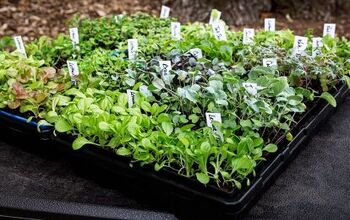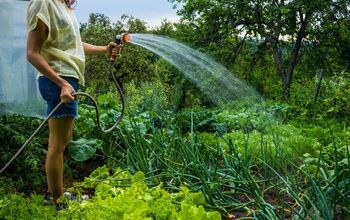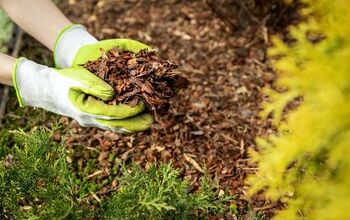What Is The Best Mulch For Vegetable Gardens?

There’s something extremely satisfying about tending to a vegetable garden and growing your own food. Whether planting leafy greens, juicy tomatoes, or crunchy broccoli, it’s also a boon to your health. Mulch helps protect plants from the elements, among other benefits, but what is the best mulch for vegetable gardens?
Compost, pine needles, and newspaper all make excellent mulch for vegetable gardens. You can also purchase mulch at the garden store but check the labels. You’ll notice some state not to use it with edibles. Other products are clearly labeled for use in vegetable gardens. Avoid using wood-based mulches, whole leaves, hay, and plastic sheeting as they can hinder vegetable growth.
Using mulch in your vegetable garden is an essential step in producing healthy, hearty veggies. But, not any mulch will do, so make sure you choose an option that works well with vegetables.
What Is The Best Mulch For Growing Vegetables?
You can use either organic or inorganic mulch when growing vegetables. Each has its own qualities regarding how they affect your veggies.
Organic mulch is a natural material, such as leaves or compost. Since it was once alive, it decomposes, returning organic matter and nutrients to the soil. This feature makes it suitable for plant growth and healthy roots, but you need to reapply it every season. (But don’t throw it away — find out what to do with your old much.)
Alternatively, you can opt for inorganic mulch choices, like gravel, landscape fabric, or rubber. These items were never alive, so they don’t decompose (or do so extremely slowly). They last longer than organic mulches and make excellent weed barriers.
So to choose which is best for you, inorganic or organic mulch, it depends on your preference. The best option for long-term growth is organic mulch because of how it helps the soil. However, if you need weed prevention and don’t want to reapply mulch every season, inorganic is a better fit.
The Top 9: Best Mulch For Vegetable Gardens
Here is a snapshot of the best mulch for vegetable gardens, with a look at their pros and cons.
1. Grass Clippings
A layer of two to four inches of dried-out grass clippings makes excellent, cost-friendly mulch. It’s also eco-friendly and easily accessible since you’re getting it from your own yard.
Plus, you can mix it into the soil at the end of the growing season. Just make sure it doesn’t contain herbicides or pesticides, and fluff it occasionally to avoid it getting slimy or smelly.
2. Compost
Roughly two to three inches of compost provides an eco-friendly, organic mulch to your garden. It’s great for the DIY gardener, nutrient-rich, and helps prevent soil erosion. But on the downside, you need to wait for it to decompose, and it can attract critters.
3. Pine Needles
This option is especially good for tomatoes, cauliflower, and other acid-loving veggies. But they’ll neutralize as they decompose, so no need to worry about the soil. Pine straw is also long-lasting (about two to three years), and it can add a pleasant scent to your garden.
You need about a three to four-inch layer. Don’t use it with plants that prefer a more alkaline soil. Also, dried pine straw can present a fire risk.
4. Shredded Leaves
Leaves can add nutrients to the soil as they decompose, and they do so quickly. You need about two to three inches of shredded leaves. Shredded leaves are another budget-friendly option since you can gather them from your yard.
But keep in mind that dry leaves can blow away easily and be a fire hazard. If they get wet, they can become stinky.
5. Straw
Using three to four inches of straw helps keep the soil moist and aerated. It’s also inexpensive and does a good job regulating the temperature of the soil throughout the winter.
But, you need to make sure it’s free from weed seed. It can also blow away easily, attract critters, and poses a potential fire hazard.
6. Newspaper
Here’s a creative way to recycle that old newspaper. Spread about three to eight sheets over your veggie garden to create a weed barrier. The paper is porous enough to allow water and oxygen through, but avoid using glossy sheets.
However, it doesn’t look as pretty and can rob the soil of nitrogen and attract rodents. One option is to use about three sheets as a weed barrier and top with another mulch option.
7. Shredded Cardboard
Similar to newspaper, a single layer of shredded cardboard is porous enough to allow in moisture and oxygen while preventing weeds. But it can attract rodents and blow away easily, eroding in wind and rain.
8. Cocoa Hulls
These babies attract earthworms, leading to aerated, nutrient-rich soil ideal for your veggies. They’ll also add a pleasant aroma to your garden, and you’ll need about a one-inch layer. However, if you have dogs, avoid using it since it contains theobromine, which is toxic to pups.
9. Black Plastic Sheeting
If using plastic sheeting, make sure it’s black, which warms the soil and prevents weeds. (However, if you need cool soil for certain veggies, use white or silver sheeting — not clear). You can also reuse the sheeting for the next growing season.
But plastic isn’t always the most environmentally-friendly choice, and it doesn’t look pretty. It can also potentially get too hot and damage your plants.
What Mulch Is Best In A Raised Bed Vegetable Garden?
If you’re working with a raised vegetable bed, you have many mulch options to choose from. There isn’t one best answer.
Grass clippings form an excellent weed barrier and deliver nitrogen to the soil. You also can likely gather your own from your yard, meaning your mulch costs you nothing.
Make sure to put about a four-inch layer of clippings around your plants and ensure they’re dried out first. Also, avoid using clippings treated with fertilizers, weed killers, or pesticides.
Shredded cardboard and newspaper are other good options for your raised vegetable garden. Their porosity allows water and oxygen to pass, but they still make an excellent weed barrier.
Spread a two-inch layer of newspaper (about 8 sheets) or a layer of shredded cardboard. Then, you can top it with another mulch to add extra protection from rain and wind.
Straw and pine needles can help the soil retain moisture and maintain the temperature even during inclement weather. However, make sure the straw doesn’t contain weed seeds.
Is Bagged Mulch Safe For A Vegetable Garden?
You can find several bagged mulches that you can use in a vegetable garden. In fact, you can purchase many organic mulches, like pine needles, ground bark, and straw, in bags. This way, you don’t have to gather these materials yourself if you prefer less DIY effort.
Other bagged mulches, like Scott’s Earthgro Black Color Advantage Mulch, are made from dyed forest products and safe for use around vegetables. Dyed mulches can be okay on veggies, but you must know the wood source.
Some wood is treated with various chemicals or contains things like creosote, which make it acceptable for ornamentals but not for food crops. Avoid using red mulch with veggies as it can have high levels of heavy metals and other components.
If possible, avoid using wood mulches altogether, as they can block nitrogen at the soil surface. This can throw off the nutrient balance and be devastating for smaller plants.
If you use wood mulches, treat your soil with the proper fertilizer before mulching. Also, ensure you can guarantee the wood is free from chemicals, or consider composting your own wood chips.
Other Mulches To Avoid In Vegetables Gardens
In addition to avoiding red mulch and most wood mulches, don’t put whole leaves over your veggie garden beds as mulch. Shredded leaves are an excellent mulch option, but whole leaves form a moisture trap. If your veggies’ roots don’t get enough breathing room, it will lead to fungal disease and rot.
Also, avoid hay containing grain and weed seeds, which make it insufficient as a mulch. If you want to use hay, look for salt hay (weed-free). Clear plastic sheeting is also a subpar mulch since it doesn’t prevent weed growth.
A Final Look At The Best Mulch For Vegetable Gardens
Using mulch in your vegetable garden has many benefits, including insulating the soil and preventing weeds. It also helps the soil retain moisture and protects it from erosion. Mulch can help prevent the spread of various soil-borne diseases that could otherwise splash up on your plants.
You can use either organic or inorganic materials as mulch in your vegetable garden. Organic options decompose and deliver nutrients to the soil, making it optimal for long-term growth. But inorganic mulches make great weed barriers, and you don’t need to reapply them every season.
Some of the best mulch for vegetable gardens are grass clippings, compost, pine needles, newspaper, and shredded leaves. You should avoid using red mulch, which can contain heavy metals and other unfavorable ingredients.
Wood mulch is also best avoided unless you can confirm the wood’s source and that it isn’t chemically treated. If buying a commercial bagged mulch, ensure it says it’s safe to use around vegetables and food crops. If you’re unsure, consult with the manufacturer.

Stacy Randall is a wife, mother, and freelance writer from NOLA that has always had a love for DIY projects, home organization, and making spaces beautiful. Together with her husband, she has been spending the last several years lovingly renovating her grandparent's former home, making it their own and learning a lot about life along the way.
More by Stacy Randall



























